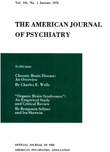Abstract
This paper has pointed out that our current facilities for the care of schizophrenic children are too limited. Children have the alternative generally of either being cared for in an outpatient facility or sent to a residential center. Surveys that are done of children who are finally admitted to residential centers indicate that this may well be a placement of last resort rather than one of choice. It often reflects failure of the community to provide proper care for the child in the early stages of his illness. Months or years of negotiations with outpatient agencies often come to naught and finally residential placement is necessary. Donald Bloch(4) has pointed out that there is an inexorable trend to institutionalization of children. Very often the way home is impossible, in spite of improvement and adequate adjustment on the part of the child at the residential center. It may well be that the lack of differentiated local treatment centers results in the inappropriate placement of a large number of mentally ill children in residential treatment centers. Thus, one searches for alternatives, for intermediate facilities that are readily available at the community level, that might serve to halt the progress of the mental illness and rehabilitate the child in an earlier, more amenable phase.
For schizophrenic children, the day hospital would appear to be ideal as one of the intermediate facilities. The number of children in residential settings, particularly in state hospitals, is increasing rapidly. Forstenzer(10) has pointed out that the number of children under 16 in state hospitals in New York State has increased from 673 on April 30, 1955 to 1,056 on March 31, 1957. Of the 1,056 who were in New York state hospitals on March 31, 1957, 377 children were less than 12 years of age, and 679 were 12 years through 15. More than 20% were in facilities other than those specifically serving children or adolescents. The change from 1955 to 1957 represents an increase of more than 57% and gives some measure of the problems confronting those responsible for organizing and administering state mental health programs. Pressures come from many sources: organizations of parents of emotionally disturbed children, judges of children's courts, schools, public welfare departments, voluntary child care agencies and civic groups in the health and welfare fields. These pressures seem to be pushing toward traditional solutions. The state has always provided for domiciliary care for the mentally ill, and thus large central institutions for the care of schizophrenic children are being built throughout the country. However, such exclusive channeling of effort may indicate that many administrators are the prisoners of an older idea.
We recognize now the very great importance of treating not only the mentally ill child, but also his family, and of centering treatment near his home, within the community. A day hospital can be established in relatively small communities as an independent unit, as part of a state hospital or as part of a public school. The experience of the League School indicates the feasibility of such a day hospital. Because of its rapid growth and the ever-increasing number of applications, the school also demonstrates the great need for such an institution in the community. Not only can a day hospital serve the needs of many schizophrenic children; it can also help the parents, and by its presence in the community, serve as a center for alerting the community to its mental health needs and gain its support for the expansion of appropriate programs.

